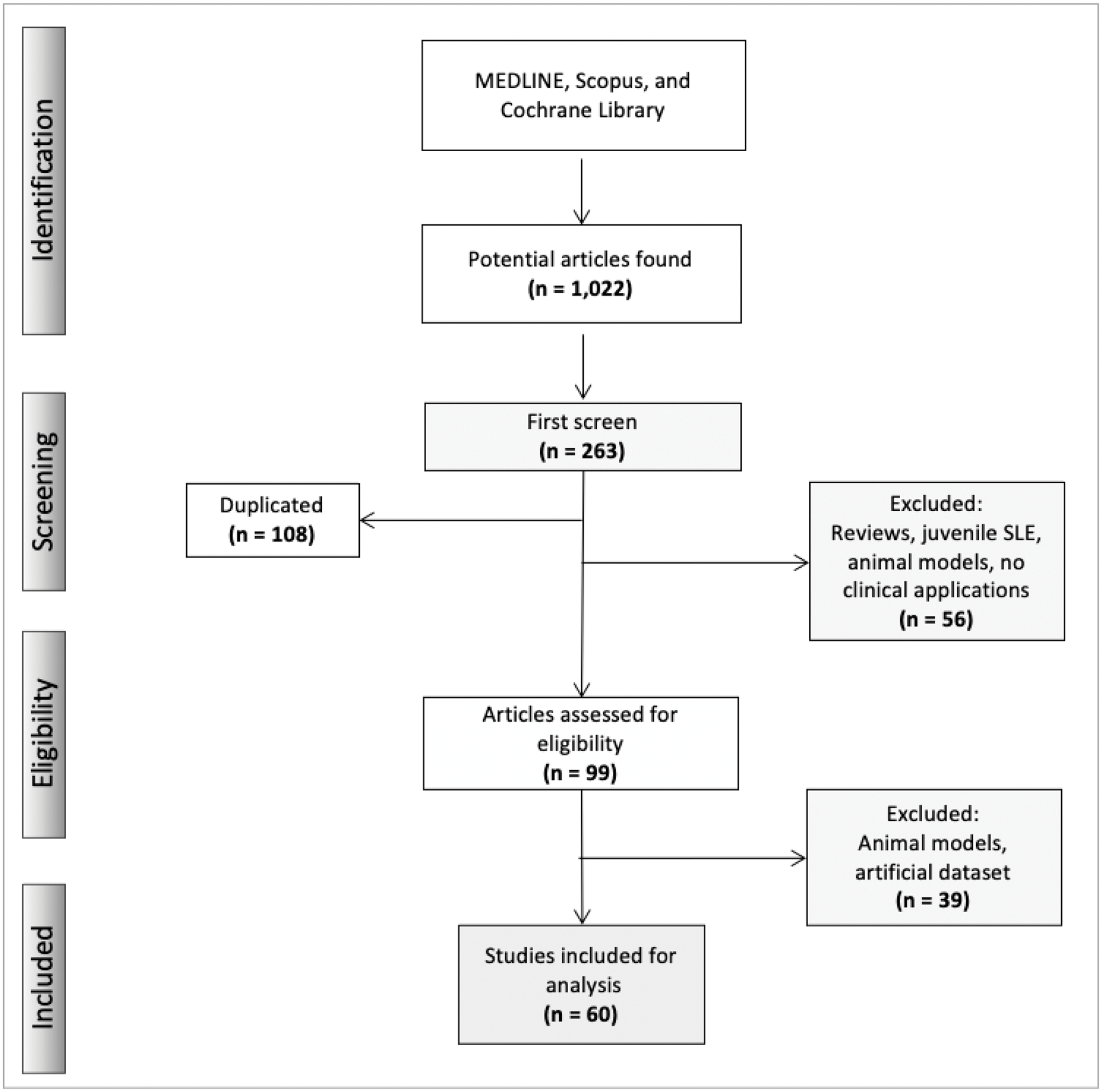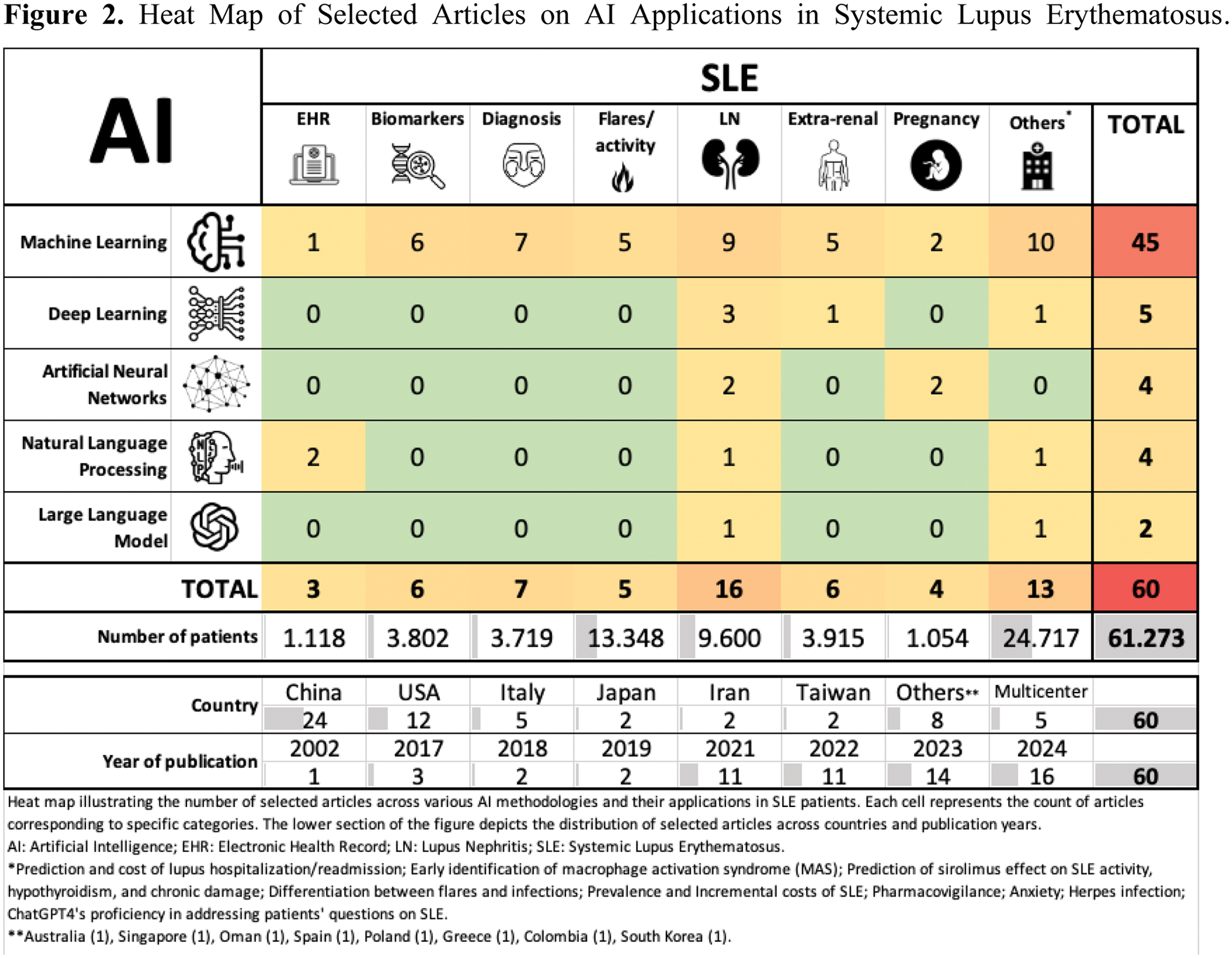

Background: Artificial Intelligence (AI) is revolutionizing healthcare, offering innovative solutions for early diagnosis, clinical and molecular phenotyping, prognosis prediction, and patient care optimization in different diseases, including systemic lupus erythematosus (SLE). Machine Learning (ML) is a subset of AI that enables systems to learn from data and improve performance over time without being explicitly programmed.
Objectives: This study aims to analyze the state of the art on clinical applications of AI tools in patients with SLE.
Methods: We conducted a systematic literature review adhering to the Preferred Reporting Items for Systematic Reviews and Meta-Analyses (PRISMA) 2020 statement guidelines. The search was completed through MEDLINE, Scopus, and the Cochrane Library databases in November 2024. The search strategy employed various combinations of MeSH terms and keywords, including: “Artificial Intelligence,” “Machine Learning,” “Deep Learning,” “Artificial Neural Networks,” “Natural Language Processing,” “Large Language Model,” and “Systemic Lupus Erythematosus.” Studies were eligible for inclusion if they met all of the following criteria: (1) availability of an abstract, (2) presentation of original data, (3) inclusion of adult patients with SLE, (4) incorporation of AI-based methodologies or tools in study design or analysis, and (5) evaluation of clinical aspects of SLE.
Results: Out of 1,022 articles identified in scientific databases, 60 fulfilled the eligibility criteria and were included in the analysis (Figure 1). These selected articles included a total of 61,273 SLE patients, in which aspects such as lupus nephritis (LN, n=16), diagnosis (n=7), biomarkers (n=6), flares/disease activity (n=5), extra-renal SLE (n=6), pregnancy (n=4), Electronic Health Records (EHRs) analysis (n=3), among others, were evaluated. Most studies were published between 2023 and 2024, with China and the USA being the most represented countries (Figure 2). ML was employed in the majority of the selected studies, accounting for 75% (45 out of 60) of the total, followed by Deep Learning (n=5), Artificial Neural Networks (n=4), Natural Language Processing (NLP, n=4), and Large Language Models (specifically ChatGPT) in 2 studies. AI, employing NLP algorithms, demonstrates the capacity to extract clinically relevant data from EHRs, thereby enhancing the identification and comprehensive clinical characterization of SLE patients. A total of 37,800 SLE patients were evaluated using ML techniques. Extreme Gradient Boosting (XGBoost), Random Forest, Logistic Regression, and Support Vector Machines were the most frequently utilized models. These models were applied to multiple aspects of the disease, focusing on LN, including biomarkers identification and prediction of proliferative lupus nephritis diagnosis, renal flares, coinfection, complete remission, and treatment response. In the context of SLE diagnosis, ML models effectively identified patterns in clinical data, predicting lupus probability and classifying patients into different diagnostic certainty levels. In the majority of cases, the performance of ML models was comparable or superior to traditional statistical models, as evaluated by area under the curve (AUC: range 0.63—0.98), accuracy (63.6—99.9%), precision (50.0—97.8%), sensitivity (35.0—99.3%), specificity (56.6—100%), and F1-Score (0.14—0.99, typically greater than 0.80). This review identifies data heterogeneity and publication bias as significant challenges that can impact the reliability and generalizability of these findings.
Flowchart of Systematic Literature Review.


Conclusion: This systematic review highlights the role of AI, especially ML, in advancing the clinical management of SLE. The results demonstrate that ML models significantly enhance diagnostic accuracy and patient care, often surpassing traditional statistical methods in some scenarios. Rigorous external validation and a clear implementation strategy are critical for translating AI tools into SLE clinical practice.
REFERENCES: [1] Ceccarelli F. Int J Mol Sci. 2023;24(5):4514.
[2] Zhan K. Lupus Sci Med. 2024;11(1):e001140.
Acknowledgements: NIL.
Disclosure of Interests: Juan Sarmiento-Monroy GSK, Astra Zeneca, Diego Benavent: None declared, Laurent Arnaud Alexion, Amgen, Astra Zeneca, Abbvie, Alpine, Biogen, BMS, Boehringer-Ingelheim, Chugaï, GSK, Grifols, Janssen-Cilag, Kezar, LFB, Lilly, Medac, Novartis, Oséus, Pfizer, Roche, UCB, José A Gómez-Puerta Astra Zeneca, GSK, Otsuka.
© The Authors 2025. This abstract is an open access article published in Annals of Rheumatic Diseases under the CC BY-NC-ND license (